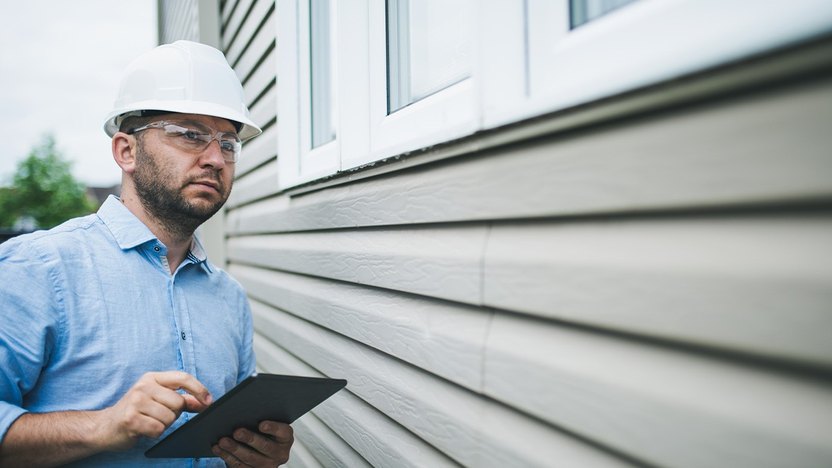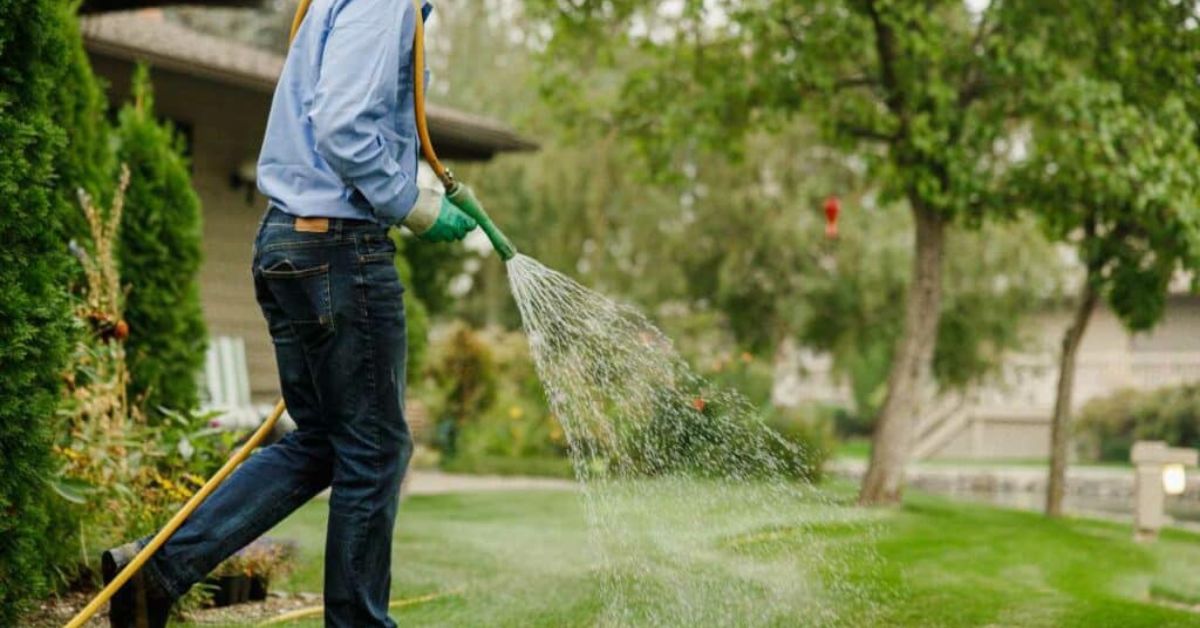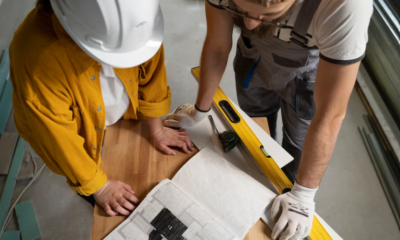HOME IMPROVEMENT
Top Building Inspection Services in Chicago: A Guide for Property Owners

When it comes to owning or managing property in the Windy City, staying on top of building inspections is crucial. Whether you’re a homeowner, a landlord, or a commercial property manager, understanding the ins and outs of Chicago Building Inspections can save you time, money, and potential legal headaches. In this comprehensive guide, we’ll explore everything you need to know about building inspections in Chicago, from why they’re important to what you can expect during the process.
Why Building Inspections Matter in Chicago
Chicago’s rich architectural history and diverse building stock make regular inspections particularly important. From century-old brownstones to sleek modern skyscrapers, each structure has its own unique set of challenges and potential issues.
Safety First
The primary purpose of building inspections is to ensure the safety of occupants and the public. Inspections can identify potential hazards before they become dangerous, such as:
- Structural issues
- Electrical problems
- Fire safety concerns
- Plumbing and sanitation issues
Compliance with City Regulations
Chicago has strict building codes and regulations. Regular inspections help ensure that your property remains compliant, avoiding costly fines and legal issues.
Maintaining Property Value
Keeping up with inspections and addressing any issues promptly can help maintain or even increase your property’s value over time.
Peace of Mind
For property owners and managers, knowing that your building has passed inspection provides peace of mind and confidence in your investment.
Types of Chicago Building Inspections
Chicago offers various types of building inspections, each serving a specific purpose. Let’s explore some of the most common:
Annual Inspections
Many buildings in Chicago are required to undergo annual inspections. These typically cover:
- General building condition
- Fire safety systems
- Elevators and escalators
- Electrical systems
- Plumbing and sanitation
Pre-Purchase Inspections
If you’re considering buying a property in Chicago, a pre-purchase inspection is crucial. This comprehensive evaluation can uncover:
- Structural issues
- Electrical and plumbing problems
- Roof condition
- HVAC system status
- Potential code violations
Complaint-Based Inspections
The City of Chicago also conducts inspections based on complaints from tenants or neighbors. These can cover a wide range of issues, from minor maintenance problems to serious safety concerns.
Special Inspections
Certain buildings or circumstances may require special inspections, such as:
- High-rise exterior wall inspections
- Energy efficiency audits
- Accessibility compliance checks
The Chicago Building Inspections Process
Understanding what to expect during a building inspection can help you prepare and ensure a smooth process. Here’s a general overview:
Scheduling the Inspection
Depending on the type of inspection, you may need to schedule it yourself or the city may contact you to set up a time.
Preparation
Before the inspection:
- Gather relevant documentation (e.g., previous inspection reports, permits)
- Ensure all areas of the building are accessible
- Address any known minor issues
During the Inspection
The inspector will:
- Examine the building’s exterior and interior
- Check major systems (electrical, plumbing, HVAC)
- Review safety features (fire escapes, smoke detectors)
- Take notes and possibly photographs
After the Inspection
You’ll receive a report detailing:
- Passed items
- Areas of concern
- Violations that need to be addressed
- Timeline for making necessary repairs or improvements
Common Issues Found During Chicago Building Inspections
While every building is unique, some issues tend to come up frequently during inspections in Chicago:
Structural Concerns
- Foundation cracks or settling
- Water damage or mold
- Roof leaks or damage
Electrical Problems
- Outdated wiring
- Overloaded circuits
- Improper grounding
Fire Safety Issues
- Malfunctioning smoke detectors
- Blocked fire escapes
- Outdated fire suppression systems
Plumbing and Sanitation
- Leaky pipes
- Inadequate water pressure
- Faulty water heaters
Code Violations
- Unpermitted renovations
- Improper use of space (e.g., illegal conversions)
- Accessibility issues
Preparing for Your Building Inspection
Taking proactive steps can help ensure a successful inspection:
Regular Maintenance
Keep up with routine maintenance throughout the year. This includes:
- Checking and replacing smoke detector batteries
- Inspecting and cleaning gutters
- Servicing HVAC systems
Address Known Issues
If you’re aware of any problems, address them before the inspection if possible. This shows good faith and can prevent more serious violations.
Organize Documentation
Keep all relevant paperwork organized and easily accessible, including:
- Previous inspection reports
- Maintenance records
- Permits for any recent work
Educate Tenants
If you’re a landlord, make sure your tenants understand the importance of the inspection and what to expect.
After the Inspection: Next Steps
Once you’ve received your inspection report, it’s time to take action:
Review the Report Thoroughly
Understand each item noted in the report, including:
- Severity of issues
- Required actions
- Deadlines for compliance
Prioritize Repairs
Create a plan to address any violations or concerns, prioritizing based on:
- Safety implications
- Compliance deadlines
- Budget considerations
Seek Professional Help
For complex issues or major repairs, don’t hesitate to seek help from qualified professionals such as:
- Licensed contractors
- Structural engineers
- Electricians or plumbers
Follow-Up Inspections
If violations were found, schedule any required follow-up inspections to ensure compliance.
The Importance of Choosing the Right Inspector
While the City of Chicago conducts many inspections, there are times when you might need to hire a private inspector, such as for a pre-purchase inspection. When choosing an inspector:
Look for Qualifications
Ensure the inspector is:
- Licensed and insured
- Experienced with Chicago’s building codes
- Familiar with the type of property you own
Check References
Don’t hesitate to ask for and check references from previous clients.
Understand the Scope
Make sure you know exactly what the inspection will cover and what type of report you’ll receive.
Staying Informed: Chicago Building Codes and Regulations
Keeping up with Chicago’s building codes and regulations is an ongoing process. Here are some ways to stay informed:
City Resources
The City of Chicago offers various resources for property owners, including:
- Online guides and FAQs
- Workshops and seminars
- Newsletters and updates
Professional Associations
Consider joining or following professional associations related to property ownership or management in Chicago. These organizations often provide valuable updates and resources.
Legal Counsel
For complex issues or major projects, consulting with a lawyer who specializes in Chicago real estate law can be invaluable.
The Future of Building Inspections in Chicago
As technology advances and building practices evolve, so too will the process of building inspections. Some trends to watch for include:
Digital Reporting
Expect to see more inspectors using tablets and digital tools to conduct and report on inspections, potentially speeding up the process.
Drone Inspections
For hard-to-reach areas like roofs or tall buildings, drone technology may become more common in inspections.
Energy Efficiency Focus
As Chicago continues to prioritize sustainability, expect to see more emphasis on energy efficiency in building inspections.
Conclusion
Navigating the world of Chicago Building Inspections may seem daunting, but it’s an essential part of responsible property ownership in the Windy City. By understanding the process, preparing thoroughly, and addressing issues promptly, you can ensure that your property remains safe, compliant, and valuable.
Remember, building inspections aren’t just about passing a test – they’re about maintaining the safety and integrity of your property for years to come. Whether you’re dealing with a historic brownstone in Lincoln Park or a modern condo in the Loop, staying on top of inspections is key to protecting your investment and the people who call your property home.
By embracing the inspection process and using it as a tool for continuous improvement, you can ensure that your Chicago property stands strong, safe, and beautiful for generations to come. Here’s to your success as a responsible and informed property owner in one of America’s greatest cities!
Also, read this: Your Complete Guide to New Home Construction Phase Inspections
HOME IMPROVEMENT
Water-Efficient Lawns: Advanced Irrigation Techniques for Today’s Homes

Homeowners are increasingly seeking ways to maintain lush, green yards while conserving water and lowering utility costs. Traditional watering methods often lead to waste through runoff, evaporation, or overwatering, especially during hot or dry seasons. Adopting smarter watering habits that align with changing environmental needs is essential to keeping outdoor spaces healthy and sustainable.
Modern systems make it easier to achieve efficiency without sacrificing appearance. Tools like smart timers, drip lines, and moisture sensors transform water delivery. Lawn irrigation systems that adapt to weather and soil conditions help minimize waste and ensure that grass and plants receive the right amount of hydration. These solutions support responsible water use and reduce long-term maintenance efforts, making them ideal for today’s resource-conscious homeowners.
Smart Irrigation Controllers
Smart irrigation controllers are revolutionizing lawn care and water conservation by automatically adjusting watering routines based on real-time weather data, historic patterns, and soil conditions. These controllers monitor rainfall, evaporation, temperature, and humidity to tailor watering to specific lawn needs. They can be managed remotely through smartphone apps, allowing homeowners to change settings based on climate conditions or personal preferences. Switching to smart irrigation can reduce water consumption by up to 30%.
Drip Irrigation Systems
Modern homeowners increasingly use advanced irrigation methods to maintain healthy, water-efficient lawns without excessive waste. Systems like drip irrigation target plant roots directly, reducing evaporation and runoff while ensuring consistent moisture levels. These techniques are especially effective in areas with water restrictions or hot, dry climates. Integrating such methods into landscaping plans can enhance function and appearance, supporting sustainable yard care. Smart controllers and moisture sensors can optimize water use, adjusting output based on weather or soil conditions. These innovations promote healthier lawns and gardens while conserving a critical resource, aligning with environmentally responsible home practices.
Rain Sensors
Rain sensors are essential components of modern water-saving irrigation systems. They automatically shut off watering during and after rain, preventing overwatering and protecting plants from excessive moisture that can suffocate roots and promote weeds. In areas with unpredictable rainfall, rain sensors are a practical upgrade that quickly pays for itself through reduced water bills and healthier lawns. For homeowners looking to enhance water efficiency, rain sensors are a valuable solution that extends irrigation equipment’s life by ensuring it’s only used when necessary.
Soil Moisture Sensors
Soil moisture sensors are essential for optimized irrigation. They monitor soil water content, activating your irrigation system only when necessary. Setting moisture thresholds prevents overwatering, which wastes water and can harm plant roots. Installing sensors at various depths ensures all plants receive proper hydration.
These sensors save water and promote healthier root systems, encouraging deeper growth and making plants more drought-resistant and less disease-prone. Integrating them into your irrigation strategy is a simple but effective way to enhance eco-friendly lawn care.
High-Efficiency Sprinkler Heads
Upgrading to high-efficiency sprinkler heads is a simple yet impactful way to enhance your irrigation system. These modern devices use precision nozzles and advanced spray patterns to distribute water evenly, reducing runoff and waste. Unlike conventional sprinklers, which can lose water to wind or evaporation, high-efficiency heads provide reliable coverage.
They are particularly beneficial for lawns with unique shapes or landscaping challenges, preventing patchy areas and flooding. Compatible with most existing systems, these heads offer a cost-effective solution to improve the health and appearance of your outdoor space while lowering water bills.
HOME IMPROVEMENT
Saving Time and Money with Oven, Range & Stove Repair Pro

It was just another weeknight in Manhattan when Melissa realized her oven wasn’t heating properly. With her kids hungry and a half-cooked casserole waiting, she scrambled to find an appliance repair service near me. After a quick online search, she came across Oven, Range & Stove Repair Pro and called 646-980-6968. Within hours, a technician arrived and saved dinner along with her evening.
Like Melissa, many homeowners don’t realize how much time and money they can save by working with the best professional appliance repair service in their area. Let’s explore how Oven, Range & Stove Repair Pro can help you get your kitchen back in shape without the stress or high cost.
Early Repairs Prevent Expensive Replacements
A small issue in your stove, oven, or range can turn into a major breakdown if ignored. A burner that won’t light or an oven that heats unevenly might seem manageable, but over time, these small problems can damage the appliance’s core components.
By hiring a professional appliance repair company like Oven, Range & Stove Repair Pro, you can catch problems early and avoid the cost of a full replacement. Their team of expert appliance repair technicians knows how to detect minor faults before they become serious.
This proactive approach is what makes them one of the best appliance repair service providers in Manhattan.
Fast Service That Keeps Your Routine On Track
Busy schedules don’t allow for long delays, especially when essential appliances stop working. That’s why speedy appliance technicians are essential in today’s world.
With speedy appliance technicians near me dispatched the same day you call, Oven, Range & Stove Repair Pro minimizes downtime. Whether you’re dealing with a broken range or a faulty stovetop, their team works fast without sacrificing quality.
Looking for a local appliance repair team that responds quickly? Call 646-980-6968 and get your repair done right the first time.
Professional Technicians Deliver Long-Term Value
DIY videos and budget repairmen may seem like money-saving options, but poor workmanship often leads to more damage. That’s why investing in professional appliance technicians near me is actually more affordable in the long run.
Oven, Range & Stove Repair Pro provides trained and licensed professional appliance technicians who understand all brands and models. They arrive fully equipped and ready to fix problems the right way.
This dedication to quality makes them a standout appliance repair company among others in Manhattan.
Affordable Appliance Repair That Fits Your Budget
Cost is one of the biggest concerns for homeowners facing appliance issues. Luckily, Oven, Range & Stove Repair Pro is known as an affordable appliance repair company offering top-tier service without breaking the bank.
Their pricing is upfront and fair. As an affordable appliance repair service, they provide accurate estimates, avoid unnecessary upsells, and ensure every dollar is well spent.
So if you’re looking for the best local appliance repair without inflated prices, this is the team to trust.
Specialized Experts for Ovens, Ranges, and Stoves
Not all technicians are qualified to fix cooking appliances. You need a stove repair professional who understands safety, gas lines, electronics, and heating mechanisms.
Oven, Range & Stove Repair Pro employs the best oven repair professionals, range repair professionals, and stove repair professionals near me to ensure that no matter the issue, you get specialized help.
From poor heating and broken knobs to full ignition failure, their affordable range repair professionals are trained to handle it all. If your appliance is misbehaving, don’t wait, call 646-980-6968 for expert assistance.
Local Knowledge Matters in Manhattan
Finding a repair team that knows the area is more valuable than most homeowners realize. When you hire Oven, Range & Stove Repair Pro, you’re choosing a business that understands the common appliance brands, building codes, and customer expectations in Manhattan.
As a local appliance repair expert, they bring a personal touch, fast access, and proven results. They’re not just another business, they’re your neighbors, and they treat your appliances with the same care as their own.
Long-Term Peace of Mind with the Right Partner
Working with the wrong repair company can lead to repeat visits, incomplete fixes, or voided warranties. With Oven, Range & Stove Repair Pro, you’re partnering with a team that guarantees their work and takes responsibility for delivering lasting results.
Their reputation as the best expert appliance repair team in Manhattan is backed by five-star reviews, return customers, and a track record of excellence. They’re not only a service provider, they’re a solution.
Conclusion: Save More with the Right Repair Service
When your kitchen appliances start acting up, it’s tempting to put off repairs or look for the cheapest option. But when you choose Oven, Range & Stove Repair Pro, you’re investing in speed, quality, and long-term savings.
Their commitment to timely service, expert repairs, and affordable pricing makes them the best appliance repair service in Manhattan. Whether it’s a minor glitch or a major issue, don’t wait until it’s too late.
HOME IMPROVEMENT
Rug Cleaning in Singapore: 6 Mistakes That Ruin Your Rugs

Your beautiful rugs add warmth and personality to your home, but they also face unique challenges in Singapore’s tropical climate. Many homeowners make costly mistakes when caring for their rugs, often causing more damage than the original problem they were trying to solve. Understanding these common errors helps you protect your investment and maintain your rugs’ beauty for years to come.
Why Rug Care Matters More in Singapore
Singapore’s consistently high humidity levels create the perfect environment for mould, mildew, and dust mites to thrive in your rugs. With humidity averaging over 80% year-round, your rugs absorb moisture from the air constantly, making them vulnerable to problems that don’t affect rugs in drier climates. Professional rug cleaning in Singapore becomes essential when you consider how quickly these issues can develop in our tropical environment.
1. Over-Wetting Your Rugs During Cleaning
Water seems harmless enough, but using too much water when cleaning your rugs creates serious problems. Excessive moisture seeps deep into the rug fibres and padding, where it can remain trapped for days or even weeks. This trapped moisture becomes a breeding ground for mould and mildew, which can permanently damage your rug and create health hazards for your family. When cleaning spills, use a well-wrung cloth that doesn’t drip water onto your rug.
2. Scrubbing Stains Too Aggressively
When you discover a stain on your expensive rug, your first instinct might be to scrub it vigorously until it disappears. This approach actually drives the stain deeper into the fibres while damaging the delicate rug structure. Hard scrubbing can cause your rug to look worn and frayed, especially around the areas where you’ve been working on stains. Instead, blot stains gently with a clean cloth and appropriate cleaning solution.
3. Using the Wrong Cleaning Products
Different rug materials require specific cleaning approaches, and using the wrong products can cause permanent discolouration or damage. Wool rugs need different care than synthetic materials, and natural fibre rugs react differently to cleaning chemicals than machine-made options. Research cleaning products carefully before applying them to your rug, and always test any new product on a small, hidden area first.
4. Leaving Spills Untreated for Too Long
Singapore’s humid climate means that spills and stains set much faster than they would in drier environments. What might seem minor today can become a permanent stain within 24 hours when combined with our tropical humidity. Food spills, pet accidents, and drink spillages need immediate attention to prevent them from penetrating deep into your rug fibres, where they become nearly impossible to remove completely.
5. Over-Shampooing During Deep Cleaning
Using too much shampoo or failing to rinse thoroughly after cleaning creates residue buildup that attracts more dirt over time. This residue makes your rug look dull and can cause the fibres to break down prematurely. In Singapore’s humid climate, soap residue also provides additional moisture that encourages mould growth and creates musty odours that circulate throughout your home.
6. Relying Only on DIY Cleaning Methods
While regular vacuuming and spot cleaning help maintain your rugs, they cannot address the deep-seated dirt, allergens, and moisture that accumulate in Singapore’s climate. Professional cleaning reaches areas that home cleaning cannot access, removing dust mites, bacteria, and allergens that affect your family’s health. Most homeowners wait until their rugs look visibly dirty, but by then, significant damage may have already occurred.
Professional Solutions for Singapore’s Climate Challenges
When these mistakes feel overwhelming or when your rugs need deeper care than home methods can provide, professional services offer systematic solutions designed for Singapore’s specific challenges. Be Mitey Clean understands the unique requirements of rug cleaning in Singapore and uses specialised equipment that addresses both surface stains and deep-seated moisture issues that develop in our humid climate.
Their multi-step process includes pre-inspection to identify specific cleaning needs, dust mite removal systems that target allergens, and controlled moisture extraction that prevents over-wetting problems. The company’s experience with Singapore’s tropical conditions means they understand how to clean rugs thoroughly while ensuring proper drying to prevent mould and mildew development.
Protecting Your Investment
Your rugs represent significant investments in your home’s comfort and style, and protecting them from these common mistakes ensures they continue serving your family for years to come. Regular professional rug cleaning service in Singapore, combined with proper home maintenance, addresses the unique challenges our climate presents while preserving your rugs’ beauty and extending their lifespan.
Understanding these mistakes helps you make informed decisions about rug care and recognise when professional intervention can save you from costly replacement expenses. Your rugs deserve protection from Singapore’s challenging climate, and avoiding these common errors is the first step toward maintaining their value and appearance.
-

 TECHNOLOGY2 years ago
TECHNOLOGY2 years agoElevating Game Day Eats: A Guide to Crafting Crowd-Pleasing Sliders
-

 ENTERTAINMENT2 years ago
ENTERTAINMENT2 years agowave_of_happy_: Your Ultimate Guide
-

 FASHION2 years ago
FASHION2 years agoGPMsign Fashion: Redefining Style with Purpose
-

 TECHNOLOGY1 year ago
TECHNOLOGY1 year agoTrader Joe’s Dayforce: Revolutionizing Workforce Management
-

 FOOD2 years ago
FOOD2 years agoAltador Cup Food Court Background: A Culinary Extravaganza Unveiled
-

 SPORTS2 years ago
SPORTS2 years agoScore Chaser Sporting Clays: A Thrilling Pursuit of Precision
-

 HOME IMPROVEMENT1 year ago
HOME IMPROVEMENT1 year agoWhat Kitchen Renovation Companies Offer Beyond Basic Remodeling
-

 NEWS2 years ago
NEWS2 years agoNyl2 Kemono: Unveiling the World
